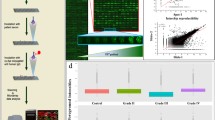Abstract
Protein microarrays are a diverse and high-throughput platform for screening biomolecular interactions, autoantigens, and protein expression profiles across tissues, etc. Autoantibodies produced against aberrant protein expression are often observed in malignancies which makes protein microarrays a powerful platform to elucidate biomarkers of translational interest. Early diagnosis of malignancies is an enduring clinical problem that has a direct impact on disease prognosis. Here, we provide an overview of a method employed to screen autoantibodies using patient sera in brain tumors. In case of brain malignancies, early diagnosis is particularly challenging and often requires highly invasive brain biopsies as a confirmatory test. This chapter summarizes the various considerations for applying a serum-based autoantibody biomarker discovery pipeline that could provide a minimally invasive initial diagnostic screen, potentiating classical diagnostic approaches.
Shabarni Gupta and Arghya Banerjee are co-first authors.
Access this chapter
Tax calculation will be finalised at checkout
Purchases are for personal use only
Similar content being viewed by others
References
Neal RD, Tharmanathan P, France B et al (2015) Is increased time to diagnosis and treatment in symptomatic cancer associated with poorer outcomes? Systematic review. Br J Cancer 112:S92–S107
(2018) Early detection: a long road ahead. Nat Rev Cancer 18:401
Sahm F, Schrimpf D, Jones DTW et al (2016) Next-generation sequencing in routine brain tumor diagnostics enables an integrated diagnosis and identifies actionable targets. Acta Neuropathol 131:903–910. https://doi.org/10.1007/s00401-015-1519-8
Gupta S, Ray S, Talukdar A et al (2016) Geographic pervasiveness of cancer: prospects of novel biomarker and therapeutic research in developing countries using OMICS approaches. In: Biomarker discovery in the developing world: dissecting the pipeline for meeting the challenges. Springer, India, pp 9–17
Delves PPJ (2015) Overview of the immune system - immune disorders - MSD manual consumer version. In: MSD Manuals. https://www.msdmanuals.com/home/immune-disorders/biology-of-the-immune-system/overview-of-the-immune-system. Accessed 15 Oct 2020
Gonzalez S, González-Rodríguez AP, Suárez-Álvarez B et al (2011) Conceptual aspects of self and nonself discrimination. Self Nonself 2:19–25
Zaenker P, Gray ES, Ziman MR (2016) Autoantibody production in cancer-the humoral immune response toward autologous antigens in cancer patients. Autoimmun Rev 15:477–483
Gupta S, Srivastava S (2019) Prospects of translational proteomics and protein microarrays in oligodendroglioma. In: Oligodendroglioma: clinical presentation, pathology, molecular biology, imaging, and treatment. Elsevier, Amsterdam, pp 117–127
Liotta LA, Espina V, Mehta AI et al (2003) Protein microarrays: meeting analytical challenges for clinical applications. Cancer Cell 3:317–325. https://doi.org/10.1016/S1535-6108(03)00086-2
Hall DA, Ptacek J, Snyder M (2007) Protein microarray technology. Mech Ageing Dev 128:161–167. https://doi.org/10.1016/j.mad.2006.11.021
Hu S, Xie Z, Qian J et al (2011) Functional protein microarray technology. Wiley Interdiscip Rev Syst Biol Med 3:255–268. https://doi.org/10.1002/wsbm.118
Bertone P, Snyder M (2005) Advances in functional protein microarray technology. FEBS J 272:5400–5411
Sauer U (2017) Analytical protein microarrays: advancements towards clinical applications. Sensors (Switzerland) 17(2):256
VanMeter A, Signore M, Pierobon M et al (2007) Reverse-phase protein microarrays: application to biomarker discovery and translational medicine. Expert Rev Mol Diagn 7:625–633
Pjaweletz CP, Charboneau L, Bichsel VE et al (2001) Reverse phase protein microarrays which capture disease progression show activation of pro-survival pathways at the cancer invasion front. Oncogene 20:1981–1989. https://doi.org/10.1038/sj.onc.1204265
Mueller C, Liotta LA, Espina V (2010) Reverse phase protein microarrays advance to use in clinical trials. Mol Oncol 4:461–481. https://doi.org/10.1016/j.molonc.2010.09.003
Louis DN, Perry A, Reifenberger G et al (2016) The 2016 World Health Organization classification of tumors of the central nervous system: a summary. Acta Neuropathol 131:803–820
Takeshita Y, Ransohoff RM (2015) Blood-brain barrier and neurological diseases. Clin Exp Neuroimmunol 6:351–361
Shimizu F, Nishihara H, Kanda T (2018) Blood–brain barrier dysfunction in immuno-mediated neurological diseases. Immunol Med 41:120–128
Platt MP, Agalliu D, Cutforth T (2017) Hello from the other side: how autoantibodies circumvent the blood-brain barrier in autoimmune encephalitis. Front Immunol 8:442
Mader S, Brimberg L, Diamond B (2017) The role of brain-reactive autoantibodies in brain pathology and cognitive impairment. Front Immunol 8:1101
Roche S, Dauvilliers Y, Tiers L et al (2008) Autoantibody profiling on high-density protein microarrays for biomarker discovery in the cerebrospinal fluid. J Immunol Methods 338:75–78. https://doi.org/10.1016/j.jim.2008.07.002
Gupta S, Manubhai KP, Kulkarni V, Srivastava S (2016) An overview of innovations and industrial solutions in protein microarray technology. Proteomics 16:1297–1308
Syed P, Gupta S, Choudhary S et al (2015) Autoantibody profiling of glioma serum samples to identify biomarkers using human proteome arrays. Sci Rep 5. https://doi.org/10.1038/srep13895
Hu S, Xie Z, Onishi A et al (2009) Profiling the human protein-DNA interactome reveals ERK2 as a transcriptional repressor of interferon signaling. Cell 139:610–622
Zhu H, Bilgin M, Bangham R et al (2001) Global analysis of protein activities using proteome chips. Science 293:2101–2105. https://doi.org/10.1126/science.1062191
Burbelo PD, Gordon SM, Waldman M et al (2019) Autoantibodies are present before the clinical diagnosis of systemic sclerosis. PLoS One 14. https://doi.org/10.1371/journal.pone.0214202
Ayoglu B, Schwenk JM, Nilsson P (2016) Antigen arrays for profiling autoantibody repertoires. Bioanalysis 8:1105–1126
Duarte JG, Blackburn JM (2017) Advances in the development of human protein microarrays. Expert Rev Proteomics 14:627–641
Atak A, Mukherjee S, Jain R et al (2016) Protein microarray applications: autoantibody detection and posttranslational modification. Proteomics 16:2557–2569
Da Syu G, Dunn J, Zhu H (2020) Developments and applications of functional protein microarrays. Mol Cell Proteomics 19:916–927
Neagu M, Bostan M, Constantin C (2019) Protein microarray technology: assisting personalized medicine in oncology (review). World Acad Sci J 1:113–124. https://doi.org/10.3892/wasj.2019.15
Acknowledgments
The study was funded through MHRD-UAY Project (UCHHATAR AVISHKAR YOJANA; UAY-(MHRD)); project #34_IITB (2016) to S.S.; MASSFIIT (Mass Spectrometry Facility, IIT Bombay; BT/PR13114/INF/22/206/2015) for MS-based proteomics work; DBT, India; and CSIR, India (awarded to A.B.).
Author information
Authors and Affiliations
Corresponding author
Editor information
Editors and Affiliations
Rights and permissions
Copyright information
© 2021 Springer Science+Business Media, LLC, part of Springer Nature
About this protocol
Cite this protocol
Gupta, S., Banerjee, A., Syed, P., Srivastava, S. (2021). Profiling Autoantibody Responses to Devise Novel Diagnostic and Prognostic Markers Using High-Density Protein Microarrays. In: Barderas, R., LaBaer, J., Srivastava, S. (eds) Protein Microarrays for Disease Analysis. Methods in Molecular Biology, vol 2344. Humana, New York, NY. https://doi.org/10.1007/978-1-0716-1562-1_14
Download citation
DOI: https://doi.org/10.1007/978-1-0716-1562-1_14
Published:
Publisher Name: Humana, New York, NY
Print ISBN: 978-1-0716-1561-4
Online ISBN: 978-1-0716-1562-1
eBook Packages: Springer Protocols




